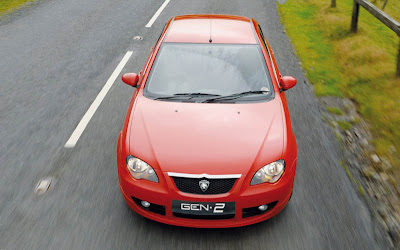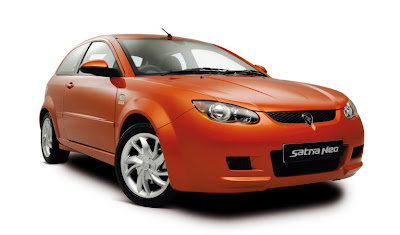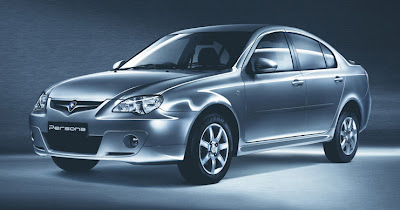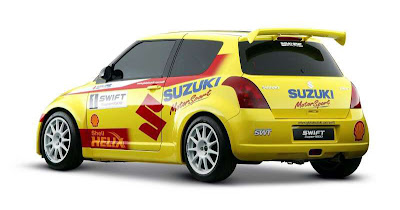Proton GEN-2, 2008




Having acquired a majority share in Group Lotus Plc in 1996 and a full share in 2003, Proton have combined the sporting heritage of Lotus with its own strengths to create the Proton GEN-2 - a car that offers far more than the average family car.
Carefully integrating the values of Proton, Lotus has helped to produce an exciting car designed for both performance and functionality, as designers and engineers deliberately chose to stray from the traditional approach of building a single car for the mass market. This integration has also become more physically visible in the Proton GEN-2 by way of the car's more modern, masculine and sporty character in terms of exterior and interior styling as well as in performance.
While Lotus presence in the older range of vehicles like the Proton Satria GTi was limited to its superior ride and handling performance, its contributions have become more visible in the Proton GEN-2 and in current Proton cars, particularly the Satria Neo. The Lotus influence is evident in the GEN-2, from underlining new and higher standards related to performance and occupant safety to sculpturing the overall look and feel of the car from both the interior and exterior.
Designed as a five-door hatchback, the Proton GEN-2 was the first of the new line of Proton cars and the first national car to be fitted with a Malaysian designed, blue-printed and commercially built engine, developed in close collaboration with Lotus.
Proton introduced the latest addition to the GEN-2 line-up in March 2008, with the launch of the Proton GEN-2 Persona saloon into the UK. The GEN-2 saloon combines the excellent performance, ride and handling of the GEN-2 hatchback, but with the added sophistication and functionality that comes with owning a 4-door family car.
The GEN-2 - a Proton through and through
Proton believes that driving should be fun and that every one of its cars should deliver superb ride and handling. Progressive technology is evident across the range - not just in performance but in safety measures and standard equipment. The Proton GEN-2 continues this tradition of offering everything motorists have come to expect from a Proton - and more.
Proton cars have always been reliable and good value for money and to maintain this Proton has added many additional features to the Proton GEN-2, making it even better value. But what sets the GEN-2 apart from the average family car is the influence of Lotus. The GEN-2 draws heavily on this, and marked a big step forward for Proton in terms of ride and handling, engine development and vehicle design.
The Proton GEN-2 hatchback and saloon are joined by three other cars in Proton range which are the five door city car the Savvy, the three door supermini the Satria Neo and the Impian four door saloon.
Exterior Design
The biggest challenge for the Malaysian designers at Proton's Styling Unit when they designed the Proton GEN-2, was not only to come up with the design for a new car, but more importantly a brand new identity that would shape Proton cars of the next generation.
Shaking off the existing Proton car image and appearance that car buyers have grown accustomed to over the last 15 years required the designers to embrace a bold and more daring approach in their designs. Equally important was to establish a presence that would disassociate future Proton cars from being perceived as rebadged variants belonging to Mitsubishi.
From the Proton GEN-2's conception there was a desire to create a family car which showed Proton was a manufacturer of exciting and passionate cars rather than conventional products. The GEN-2 was designed to have an aerodynamic and curvaceous styling not previously experienced in previous Proton vehicles, or generally found on family cars. This goal enabled designers and engineers to set a consistent and emerging styling direction for future products, giving Proton cars their own personality, character and presence.
Lotus influence in the Proton GEN-2 is strong compared to previous Proton vehicles, particularly in the exterior and interior styling, which has set out to create a more sporty and contemporary car both inside and out. The GEN-2 represents a harmonious blend of Proton and Lotus characteristics to produce a contemporary and much sportier car than previous models and set a standard which each of the current products now embodies.
In styling the Proton GEN-2, the designers opted for deeper concave lines and shoulders to make the car masculine and aggressive in appearance. Integrating Lotus characteristics into the design, the end result bore strong resemblance of a sporty coupe in line with the objective of creating a car that was more sporty than conventional.
The masculine shoulders of the GEN-2, the gentle curve of the roof and the pronounced wheel arches extend fluidly to the rear section of the car, accentuating dynamism and a powerful presence whether the car is stationary or in motion. Sporty characteristics extend to the rear of the Proton GEN-2 with radically designed rear lights positioned on the high and contoured tail end of the car, with a tailgate spoiler available on GSX and saloon models. Brand new 15" alloy wheels, available on all models, complete the look.
In addition to the stylish profile, crumple zones at the front and rear ensure passengers are as safe as possible in the event of a collision, while electronically controlled folding door mirrors (heated on GSX models) ensure ease of use for drivers. And when it comes to those tight spaces in town, reverse distance sensors ensure the GEN-2 is no problem to park.
The GEN-2 hatchback is available in a choice of six different colours including metallic Black, Chilli Red, Genetic Silver and Passion Blue and the Proton GEN-2 saloon is available in a choice of five colours, including Light Gold and Blueberry Tea.
Size
The Proton GEN-2 hatchback has an overall length of 4310mm, an overall width measuring 1725mm, a height of 1435mm and wheelbase of 2600mm. This compares very favourably with the competition, with the car being longer than many of its competitors and having improved vehicle dynamics. It has a 50 litre fuel tank and luggage area volume of 460 litres with the rear seats up and a volume of 850 litres with the seats folded down.
The GEN-2 saloon has an overall length of 4477mm, an overall width measuring 1725mm, a height of 1437mm and wheelbase of 2600mm. The saloon version has a luggage area volume of 430 litres with the seats up, which can be doubled with the seats folded down.
NVH suppression
The Proton GEN-2 aims for superior NVH characteristics which make the driving experience comfortable for occupants without eliminating the sporty engine noise. The aerodynamic profile means the GEN-2 delivers low wind resistance, good high speed manoeuvrability, vehicle stability and control.
In perfecting noise, vibration and harshness (NVH) for the GEN-2, Proton's Research and Development engineers concentrated on isolating noise at the source as one of the most effective methods to achieving higher NVH standards.
Noise produced by the engine, the intake and exhaust system were isolated and prevented from creeping into the cabin. Proton engineers also aimed at providing a measurable and significant degree of NVH performance, from addressing how the vehicle responds to vibration in various driving conditions to achieving the desired levels of stiffness, weight and the damping effects of the vehicle.
The floor pan of the Proton GEN-2, the trunk and the door panels have all been subjected to significant amounts of damping, and a great degree of attention has gone into better insulating firewall, the A, B and C pillars and the floor of the vehicle. Careful attention went into accomplishing this by way of strategically positioning the correct amount of damping sheets and insulation padding to achieve the desired NVH levels without having the additional weight compromising on the vehicle's overall performance.
Reducing wind noise was also accomplished by introducing improved door seals or weather strips that have significantly reduced air leakage into the passenger compartment and the introduction of Low Gap Technology, giving a snug panel fit and the ribbed bee sting aerial means reduced wind noise inside the cabin.
The enhanced rigidity and stiffness in the GEN-2's platform also resulted in better suspension performance, providing better vehicle stability, passenger protection and helping to eliminate unwanted and undesirable creaks. Benchmarking against a number of European, Japanese and Korean cars, these elements combined, create a more desirable in-car driving experience from how smooth the vehicle is when in motion, to delivering a solid "thud" as the doors are shut.
Lighting
Sculptured headlights give a more aggressive appearance and the front bumper has been deliberately designed to appear lower for a more sporty presence. Clear fog lights have also been integrated into the front bumper for a more dynamic stature. All Proton GEN-2 models have halogen headlamps with semi-automatic levelling as standard.
Interior Design
Simplicity, stylish and sporty were the elements Proton ergonomics experts set out to achieve as they worked to harmoniously integrate the unique characteristics between Proton and Lotus in seeking to raise the standards of a Proton car interior. The "Lotus Inside" theme is translated into a classier and more modern design of the dashboard and cockpit underlining a very strong sporty and emotional presence. Raised structures of the dashboard and positioning of the instruments and controls provide the driver and front passenger with ideal field of vision, reach and accessibility.
When you step into the Proton GEN-2, you can't miss the influence of the Lotus Design Studio in the circular styling of the controls, cowled dash, subtle red LEDs and sporty dials.
Designed to be as flexible as possible the GEN-2 easily meets the multitude of demands placed on a family car. Its spacious interior can comfortably accommodate five adults and there are child locks on the rear doors for maximum safety if carrying younger passengers and ISOfix style child restraint fixings on the back seat.
Dashboard and instruments
All the important information is clearly laid out so drivers need only take their eyes from the road momentarily to get key information. All major warning indicators are easily located, including the seatbelt warning and door ajar warning lights. Additional features include an audible seatbelt warning buzzer for front passengers and a lights on warning buzzer. In addition, all GSX models have an instrument panel dimmer so drivers can select their own brightness settings.
The materials chosen for the upper dashboard were selected for their low reflectivity, to reduce the glare from the road. The lower materials have been chosen for their durability. There are fabric or leather inserts in the door panels and the A, B and C pillars are covered with a grain plastic.
Trip computer
The Proton GEN-2 also features an on-board informative digital display system, capable of calculating average fuel consumption, journey time and distance to empty.
The average fuel consumption system calculates consumption from the total fuel used and the distance since the last reset enabling the driver to review his driving patterns in making a decision when it comes to choosing between economy and performance driving.
The journey time option shows the time in hours and minutes telling the driver how long the ignition has been switched on and the engine left running, while the distance to empty provides an estimated distance in miles to the next refuelling requirement.
Controls
The three spoke steering wheel has been improved in terms of design, function and material, aimed at offering superior grip as well as convenience, and together with the gear shifter and handbrake handle (hatchback only), accentuate the sporty nature of the car.
For additional convenience, the has steering wheel mounted audio controls volume and mute controls for the radio/CD player on the left hand side and skip, search and mode controls on the right. The steering wheel has been positioned to provide driver legroom of 930mm from the hip pivot point. The steering wheel is also height adjustable for added convenience.
Seating
The GEN-2's spacious cabin offers drivers a dark grey interior colour scheme extending to the seats, door inserts and the darker dashboard and door trim.
Body hugging one-piece seats with integrated headrest in the front give the driver and the passenger better grip and a fully secured driving feel. The driver's seat is height, tilt and slide adjustable for optimum comfort and there are two adjustable headrests for rear passengers. The hip pivot point in the GEN-2 is higher than in other cars, giving easy access in and out of the vehicle.
Luggage and storage
There are ample storage compartments around the cabin including a dashboard stowage tray, side pockets in the front doors, rear map pockets in the front seats and a centrally located cup holder. In addition there is also a central floor console box with armrest between the front seats.
The 60:40 split folding rear seats provide a versatile load area in the rear of the car, creating a large load area for extra luggage, suitcases, shopping etc. Within the boot there is a handy hook giving ease of access to the spare wheel and toolkit and every Proton GEN-2 hatchback has an internal boot strap so there is no need to get hands dirty by touching the boot of the vehicle. The toolkit contains adjustable pliers, a 12mm/14mm spanner, screwdriver, wheelbrace and towing eye and jack.
Equipment
All GLS and saloon models are fitted with an air conditioning system with pollen filter, with GSX models having automatic climate control with pollen filter as standard. The familiar vertically stacked heating controls are situated conveniently by the gear lever and complement the simplistic, minimalist and sporty look and feel.
GSX automatic models have automatic cruise control as standard, which is unusual on a car in this price range. This enables the driver to set their own constant speed. Controls for this are located on the steering column on the right hand side. Front electric windows are standard across the range, with electric rear windows on the GSX and saloon ranges. A centrally located window locking system is in place on the hatchback to prevent children having access to the electric windows when travelling in the rear.
Additional practical considerations are in abundance. The GEN-2 is equipped with illuminated power window switches, side mirror adjusters, centre mounted clock, sun visor with vanity mirror on passenger and driver side which also incorporates a ticket holder, front and rear door side armrests and a 12V power socket.
Audio
In-car entertainment comes in the form of a stylish unit which complements the interior's sporty look and feel. Each Proton GEN-2 is fitted with a Blaupunkt audio system with RDS, 20 station memory and CD player, compatible with both CDRW (hatchback only) and MP3 CDs in addition to standard CD formats. This integrated unit is only compatible with the GEN-2 so cannot be stolen and used in another vehicle.
Models in the GSX range can be equipped with a hands free telephone based on Bluetooth technology. A four-way speaker system provides for better sound distribution around the cabin.
Engines and Transmissions
The Proton GEN-2 is available with a choice of either a 1.3 (hatchback only) or 1.6 litre 16v Lotus developed CamPro petrol engine. All manual transmission models have a five-speed gearbox and a four-speed automatic option is available on 1.6 models.
Underneath the bonnet is a CamPro 4-cylinder 16v Multi-Point Injection engine developed in collaboration with Lotus. As you'd expect from a company that designs and builds high performance cars, this is an engine that packs a serious punch; with the 1.6 range delivering a max speed of up to 118mph, with 110bhp and 109lb/ft of torque.
Testing of the engine was conducted on both engine rigs and dynamometers as well as on the road with running prototypes already having completed rigorous tests all around the globe and accumulating more than 27,000 hours.
While the main proving ground for the CamPro was Malaysia, the engine has been put through the hot and engine onboard diagnostic tests in Australia. Hot and high altitude testing was conducted in Spain, high speed testing run at Millbrook in the United Kingdom and cold weather testing conducted in Sweden. A HVAC cooling test was also performed on the GEN-2 in Japan as Proton and Lotus engineers worked to create an engine designed for reliability, durability, longevity, fuss free and affordable maintenance, and performance.
Chassis
The Proton GEN-2 inherits a more rigid platform and body, and Lotus-tweaked suspension for more agility, stability, precision and control as Proton engineers pursued to provide greater active safety.
Proton and Lotus engineers reached the perfect balance between performance excellence and ride comfort in the set-up of the GEN-2, delivering a car with a sporty personality and spirited drive yet managing to attain a high degree of comfort. The goal was to create a car big on performance, and equally generous in terms of on road comfort. In essence, Proton engineers targeted the car for a specific audience - those who are in the market for a practical family car yet desire the performance and personality of a sports car.
The sporty character of the car is translated into creating a more responsive, predictable and controllable package, giving the Proton GEN-2 not only greater agility but stability. The driver registers this in the form of greater precision in terms of lane changing behaviour through an even more immediate and instantaneous response to steering movements.
A key strength that Proton has acquired through their relationship with Lotus is the ability to maximise ride and handling through total integrated body tuning and balancing; this combines to give a fun and exciting drive and translates into the GEN-2 having excellent steering, manoeuvrability, cornering and handling capabilities that can be easily distinguished in terms of cornering speeds and high-speed stability.
Good ride and handling not only makes a car more enjoyable to drive, it also improves safety by giving an accurate and instant response to driver actions. Few cars achieve good levels of both. Usually better handling means less ride comfort and vice versa. The GEN-2 has been designed to optimise both elements.
Brakes
All Proton GEN-2 models are equipped with an ABS with EBD for optimum performance. In addition, all models have brake discs all round, with 266mm ventilated at the front and 280mm solid at the rear.
Wheels
All GEN-2 models have 15 inch alloy wheels with 195/55R15 85V Continental Sport or Sime tyres with a space saver steel wheel as a spare.
Steering
The vehicle's turning circle is just 5.4m (17.7 ft) which has helped enhance around-town driveability and manoeuvrability.
Safety
Safety is a priority for Proton, who provide drivers with a range of equipment to help to prevent an accident and protect in the event of a collision. The Anti-lock Braking System (ABS) and Electronic Brake Distribution (EBS) deliver controlled, safer braking in adverse weather conditions. EBD distributes optimum braking force to the area of the vehicle that needs it the most, ensuring stability and confidence under heavy braking.
Proton aims to offer both „active' and „passive' safety and the GEN-2 does just this.
Active safety is achieved through good vehicle control, helping to avoid accidents. The Lotus input into the chassis and suspension development ensures the Proton GEN-2 has excellent handling, accurate steering and stable braking. The precision feedback and responsiveness of the steering, handling and braking ensure maximum control when on the road.
Passive safety, the minimisation of injuries in the event of an accident, has always been important at Proton and the GEN-2 has several safety features to support this. Here Proton focuses on passenger protection through built-in crumple zones, strong cabin rigidity and additional energy absorbance technology.
Proton have also utilised passenger restraint systems to reduce injuries from secondary impact. The Proton GEN-2 has independent rear headrests for improved safety for rear passengers and both front seatbelts have pre-tensioners to maintain the belt force at a controlled level and ensure passengers are held in place in an impact. In addition the driver's seatbelt is linked to an audible warning system which reminds the driver to fasten their seatbelt. There are twin airbags fitted as standard across the entire GEN-2 range with twin side airbags available on GSX models. Additional features include a collapsible steering column and a pedal anti-intrusion system, both of which help prevent penetration into the cabin during a frontal impact. The rear seats have been designed to withstand impact from luggage thrown against the back seat and therefore against rear passengers, in the event of a rear collision.
All passive safety systems have been tuned for optimal timing to reduce risk of injury.
Cruise control is standard on the GSX automatic and allows a desired speed to be maintained constantly. For safety, braking disengages the system or it can be controlled via a steering wheel switch.
Additional safety features include reverse distance sensors to alert the driver to any obstructions or people behind the vehicle and a centrally located petrol tank, making it less likely to get damaged in the event of an accident.
Security
The Proton GEN-2 comes with an integrated alarm system and an engine immobiliser with a unique encoded transponder. The three stage security system minimises the risk of vehicle theft by means of hot wire or duplication of keys, providing protection from theft. The door locking system is fitted with a free rolling key cylinder as a theft deterrent. If an intruder uses an unmatched key or attempts a forced entry on the key cylinder with a foreign object, the lock will rotate freely to prevent opening. Should a window be broken, the combination of the immobiliser and ignition lock protection will ensure that the ignition system is protected and the car cannot be driven.
The central locking cables are hidden to prevent tampering and the locks are less likely to be broken if foreign objects are inserted. To further reduce the risk of kerb-side break-ins there is only one exposed lock, on the driver's door, and no external boot release.
All security features in the GEN-2 also conform to strict Thatcham safety and security standards. All new Proton vehicles are automatically added to the International Security Register (ISR) reducing the risk of theft and resale. A single call to the ISR's 24 hour helpline enables a prospective buyer to confirm a vehicle's credentials. In addition to this, the Proton GEN-2 also has a visible VIN plate on the dashboard and many of its parts (e.g. alarm unit, ECU, seats) are all marked with a unique identification number.






















































